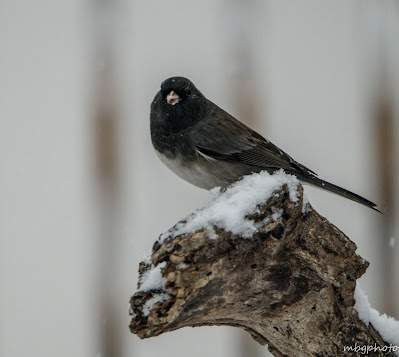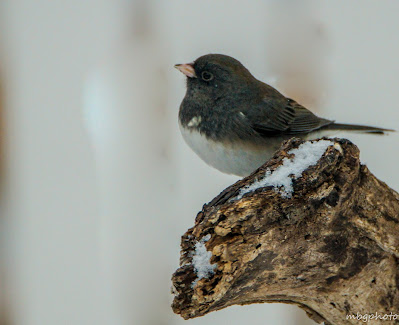I think I must have gotten my love of birds from my Mother. She loved to watch the birds in her yard and one of her favorites was a small grey bird with a white bottom that she called the "Snow Bird". I have found this bird to be one of my favorites. They are called Dark Eyed Junco's and it is particularly interesting to watch them hop around on the ground on a snowy day.
Identifying the Dark Eyed Junco
- Slate Colored mostly grey with white belly
- Medium Sized Sparrow
- Round Head
- Small pale bill
- Prominent white outer tail feathers
There are other Junco's in North America whose coloring varies across the continent but all are a dark grey or brown and have white outer tail feathers the flash open in flight. In the western US Junco's have a dark hood and a brown back. These are called the "Oregon Junco"
The Dark Eyed Junco that I show in this article are found throughout Canada and in the eastern US. I live in eastern Missouri and they are plentiful in my backyard.
Feeding Behavior
These birds feed primarily by hopping around the base of trees and shrubs looking for fallen seeds. In the spring and summer they will eat mainly insects.
In my back yard they usually are found beneath the feeders picking up seeds that have fallen when other birds have been at the feeders. Here is a photo taken on a snowy morning when two Junco's decided to stop at a feeder. The ground was covered with snow and there weren't any other birds around to knock food off the feeders so they had to go get their own. Later in the day when more other types of birds were around they were again on the ground pecking away at fallen seeds.
Breeding Behavior
In order to court the females the males will fan and flicker their tail feather and hop up and down. The males and females will make a nest together and they defend their territory together. The male however is a bit fickle and is known to mate with several females.
The females usually have between 3-5 eggs at a time and they are incubated by the female for 12-13 days. The baby birds are ready to leave their nest in 9-13 days.
Habitat
Junco's are ground nesters and prefer to make their nest on the ground sheltered by either dense shrubs or rocks. Their nest is an open cup made of fine twigs, rootlets and leaves.
References
- Cornell Lab of Ornithology online
- Backyard Guide to the Birds of North America by Jonathan Alderfer and Paul Hess
Note: The author may receive a commission from purchases made using links found in this article. “As an Amazon Associate, Ebay (EPN), Esty (Awin), and/or Zazzle Affiliate, I (we) earn from qualifying purchases.”































How interesting to learn about the dark eyed Junco and view them through your wonderful photographs, Mary Beth. While many species of birds migrate to warmer climates in winter, it's obvious the Junco is a year-round bird and that the cold and snow doesn't bother them at all. Fun fact about how they prefer to feed on seeds knocked on the ground from feeders rather than eat off the bird feeder themselves. Rather a lazy bunch, would you say? :) Perhaps they just prefer ground level dining to balancing on a feeder. Fun article about the Dark Eyed Junco.
ReplyDeleteSuch a pretty little bird! Would you believe we recently started seeing the Dark Eyed Junco in my parent's backyard and we were having a terrible time identifying them. None of the images online looked exactly like the birds my dad kept seeing. When I saw your images on facebook earlier this week, I quickly emailed my dad. He took a look and was thrilled to discover that you had just identified his newest "unknown" backyard guest. I am sorry to read that they build their nests on the ground. I fear that won't be a good thing around here due to our snake population. I love you photos and as much as I love seeing the Junco in our area, I would rather they stay safe in Missouri instead of venturing too far south.
ReplyDeleteI, too, love the Dark Eyed Junco! I look forward each year when they return to my backyard for their winter vacation. They are so fun to watch!
ReplyDeleteI live in California, and I don't believe I've ever seen the Dark Eyed Junco. I love watching and photographing birds, but I'm not very good at recognizing more than a few.
ReplyDeleteMary Beth, I love Juncos and was just watching them hopping around under the bird feeder during my last trip to The Shack. I love that your mom called them snow birds. Thank you for your gorgeous photos!
ReplyDelete